Project Management Report: Communication, Methodologies, and QAHE App
VerifiedAdded on 2022/09/11
|12
|2274
|11
Report
AI Summary
This report delves into the critical role of structured communication in project management, emphasizing its importance for setting clear goals, addressing challenges, and ensuring stakeholder engagement. It highlights the need for a communication plan and the potential consequences of its absence, using the Queensland Health Payroll project as a cautionary example. Furthermore, the report evaluates three project management methodologies—Agile, Waterfall, and PRINCE2—to determine the most suitable approach for a QAHE recreation mobile application development project. The analysis concludes that the Waterfall method is the most appropriate choice due to the project's fixed scope, requirements, budget, and timeline constraints, contrasting it with the flexibility and iterative nature of Agile and the complexity of PRINCE2. The report underscores the significance of choosing the right methodology for successful project execution, providing a comparative analysis of each method's strengths and weaknesses.
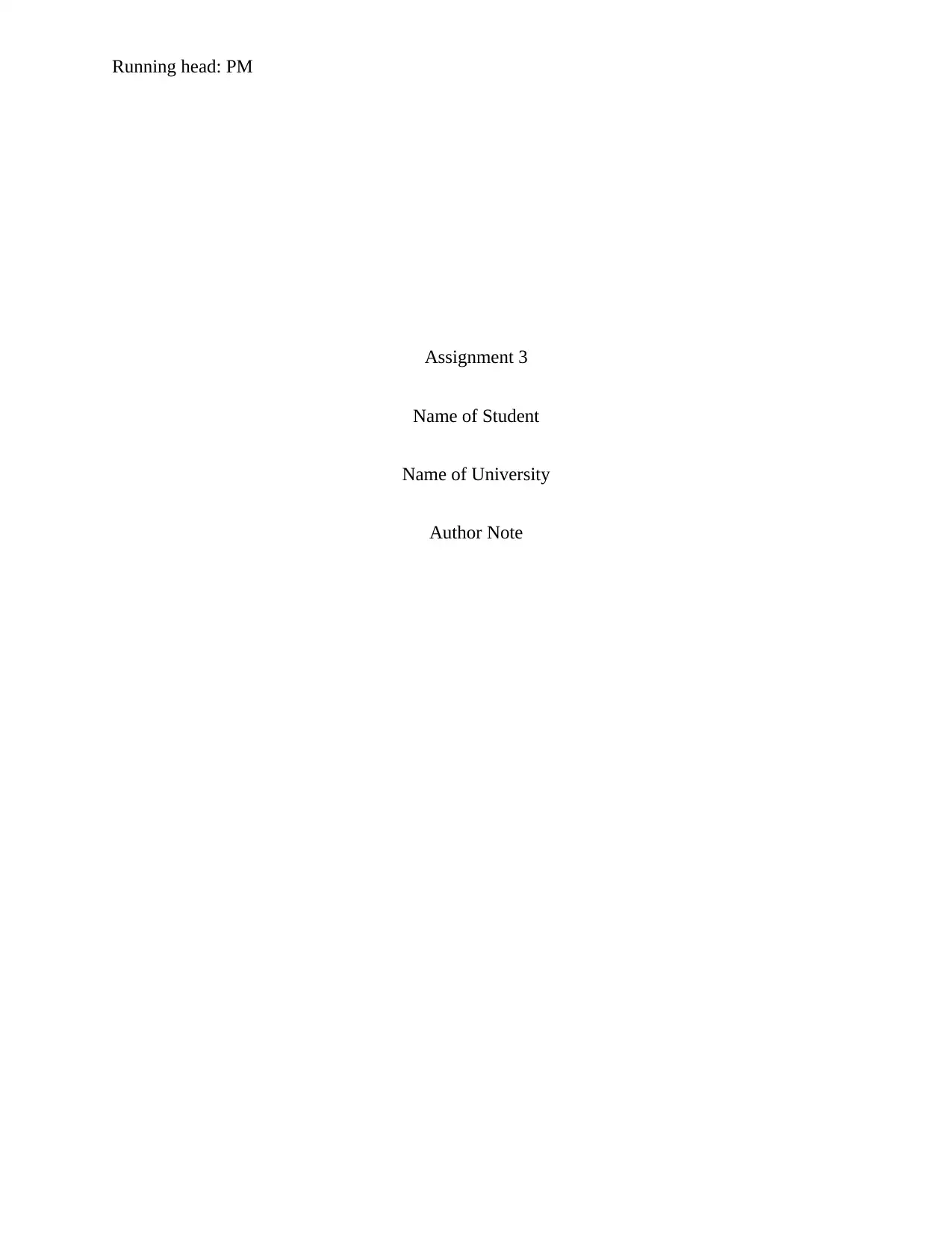
Running head: PM
Assignment 3
Name of Student
Name of University
Author Note
Assignment 3
Name of Student
Name of University
Author Note
Paraphrase This Document
Need a fresh take? Get an instant paraphrase of this document with our AI Paraphraser
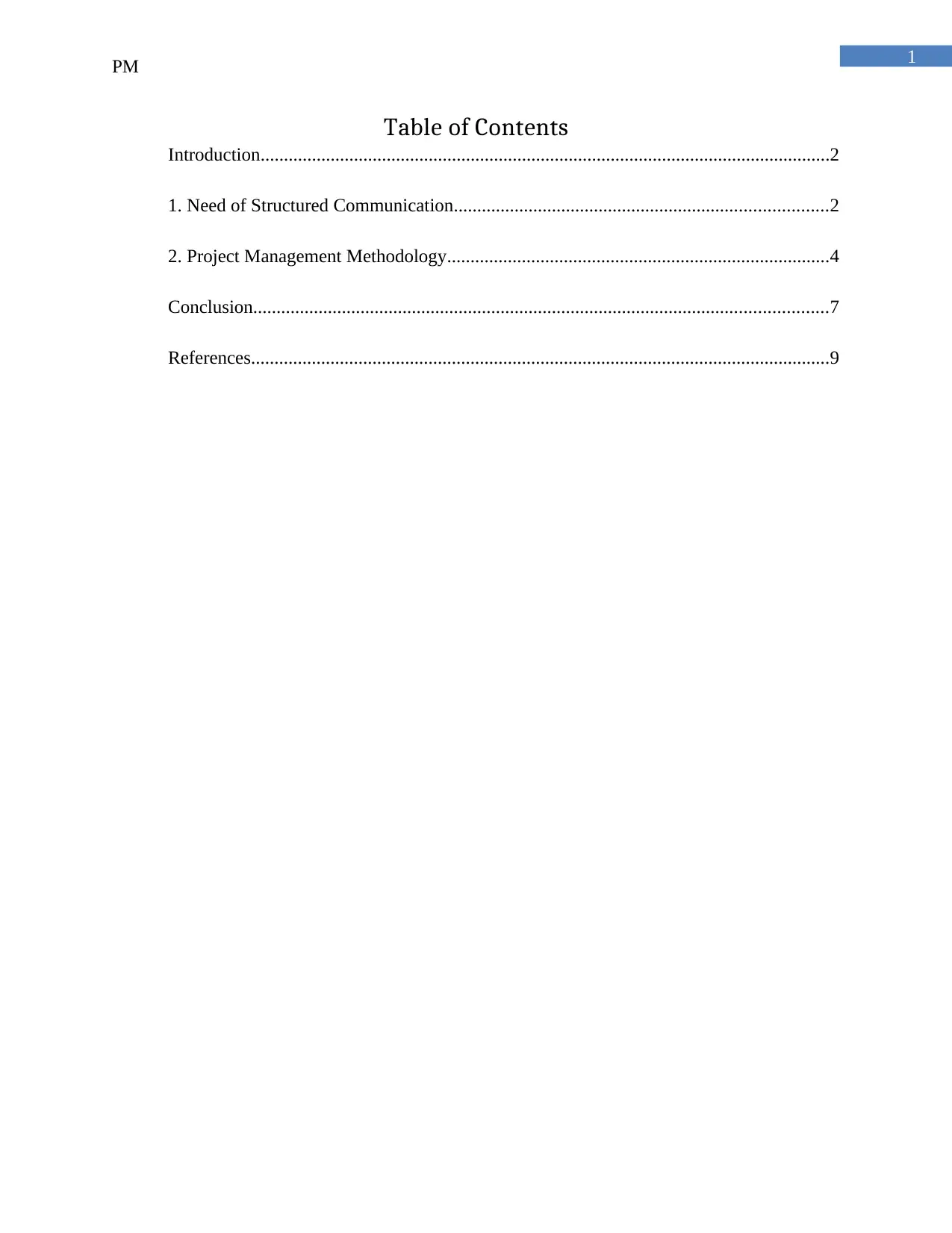
1
PM
Table of Contents
Introduction..........................................................................................................................2
1. Need of Structured Communication................................................................................2
2. Project Management Methodology..................................................................................4
Conclusion...........................................................................................................................7
References............................................................................................................................9
PM
Table of Contents
Introduction..........................................................................................................................2
1. Need of Structured Communication................................................................................2
2. Project Management Methodology..................................................................................4
Conclusion...........................................................................................................................7
References............................................................................................................................9
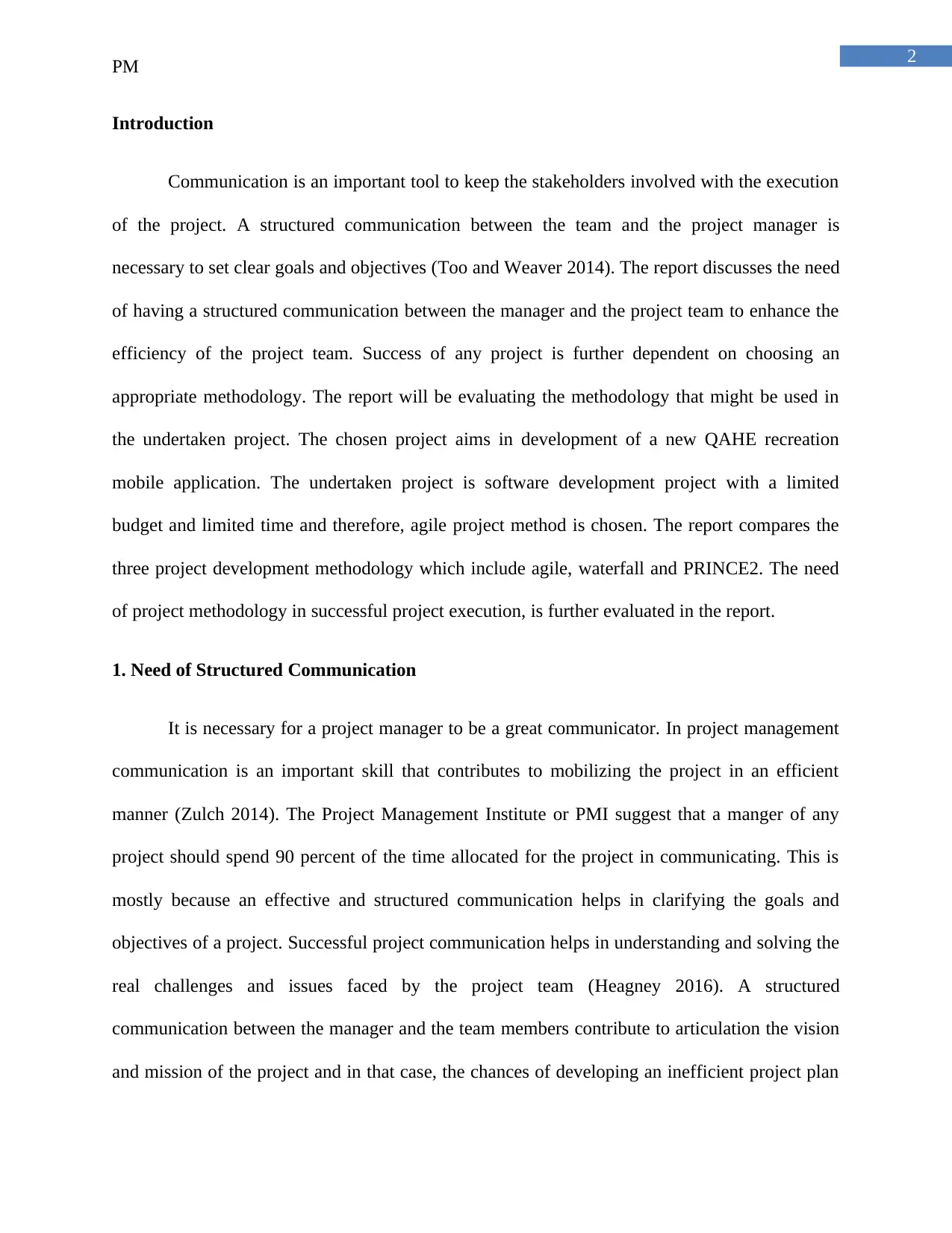
2
PM
Introduction
Communication is an important tool to keep the stakeholders involved with the execution
of the project. A structured communication between the team and the project manager is
necessary to set clear goals and objectives (Too and Weaver 2014). The report discusses the need
of having a structured communication between the manager and the project team to enhance the
efficiency of the project team. Success of any project is further dependent on choosing an
appropriate methodology. The report will be evaluating the methodology that might be used in
the undertaken project. The chosen project aims in development of a new QAHE recreation
mobile application. The undertaken project is software development project with a limited
budget and limited time and therefore, agile project method is chosen. The report compares the
three project development methodology which include agile, waterfall and PRINCE2. The need
of project methodology in successful project execution, is further evaluated in the report.
1. Need of Structured Communication
It is necessary for a project manager to be a great communicator. In project management
communication is an important skill that contributes to mobilizing the project in an efficient
manner (Zulch 2014). The Project Management Institute or PMI suggest that a manger of any
project should spend 90 percent of the time allocated for the project in communicating. This is
mostly because an effective and structured communication helps in clarifying the goals and
objectives of a project. Successful project communication helps in understanding and solving the
real challenges and issues faced by the project team (Heagney 2016). A structured
communication between the manager and the team members contribute to articulation the vision
and mission of the project and in that case, the chances of developing an inefficient project plan
PM
Introduction
Communication is an important tool to keep the stakeholders involved with the execution
of the project. A structured communication between the team and the project manager is
necessary to set clear goals and objectives (Too and Weaver 2014). The report discusses the need
of having a structured communication between the manager and the project team to enhance the
efficiency of the project team. Success of any project is further dependent on choosing an
appropriate methodology. The report will be evaluating the methodology that might be used in
the undertaken project. The chosen project aims in development of a new QAHE recreation
mobile application. The undertaken project is software development project with a limited
budget and limited time and therefore, agile project method is chosen. The report compares the
three project development methodology which include agile, waterfall and PRINCE2. The need
of project methodology in successful project execution, is further evaluated in the report.
1. Need of Structured Communication
It is necessary for a project manager to be a great communicator. In project management
communication is an important skill that contributes to mobilizing the project in an efficient
manner (Zulch 2014). The Project Management Institute or PMI suggest that a manger of any
project should spend 90 percent of the time allocated for the project in communicating. This is
mostly because an effective and structured communication helps in clarifying the goals and
objectives of a project. Successful project communication helps in understanding and solving the
real challenges and issues faced by the project team (Heagney 2016). A structured
communication between the manager and the team members contribute to articulation the vision
and mission of the project and in that case, the chances of developing an inefficient project plan
⊘ This is a preview!⊘
Do you want full access?
Subscribe today to unlock all pages.

Trusted by 1+ million students worldwide
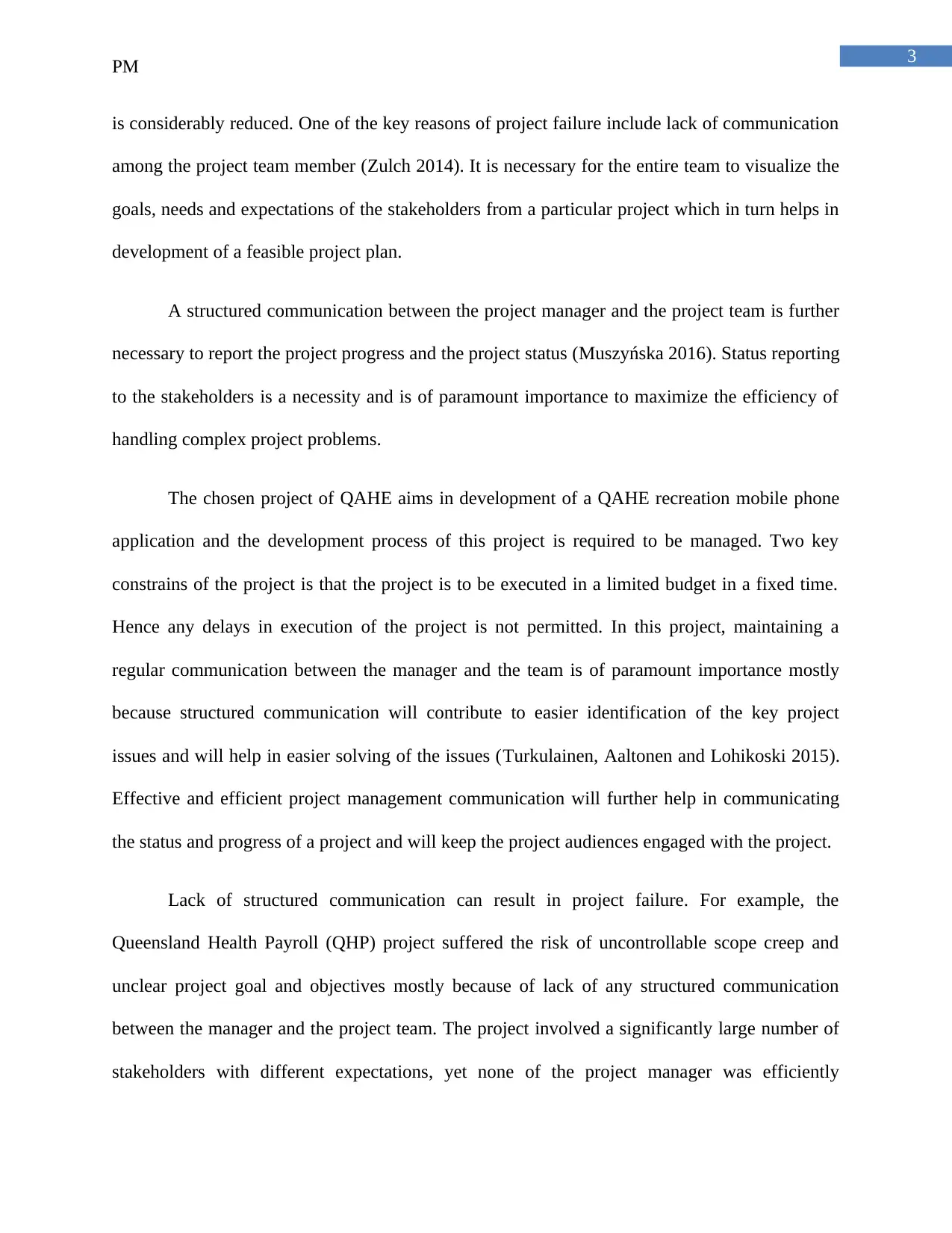
3
PM
is considerably reduced. One of the key reasons of project failure include lack of communication
among the project team member (Zulch 2014). It is necessary for the entire team to visualize the
goals, needs and expectations of the stakeholders from a particular project which in turn helps in
development of a feasible project plan.
A structured communication between the project manager and the project team is further
necessary to report the project progress and the project status (Muszyńska 2016). Status reporting
to the stakeholders is a necessity and is of paramount importance to maximize the efficiency of
handling complex project problems.
The chosen project of QAHE aims in development of a QAHE recreation mobile phone
application and the development process of this project is required to be managed. Two key
constrains of the project is that the project is to be executed in a limited budget in a fixed time.
Hence any delays in execution of the project is not permitted. In this project, maintaining a
regular communication between the manager and the team is of paramount importance mostly
because structured communication will contribute to easier identification of the key project
issues and will help in easier solving of the issues (Turkulainen, Aaltonen and Lohikoski 2015).
Effective and efficient project management communication will further help in communicating
the status and progress of a project and will keep the project audiences engaged with the project.
Lack of structured communication can result in project failure. For example, the
Queensland Health Payroll (QHP) project suffered the risk of uncontrollable scope creep and
unclear project goal and objectives mostly because of lack of any structured communication
between the manager and the project team. The project involved a significantly large number of
stakeholders with different expectations, yet none of the project manager was efficiently
PM
is considerably reduced. One of the key reasons of project failure include lack of communication
among the project team member (Zulch 2014). It is necessary for the entire team to visualize the
goals, needs and expectations of the stakeholders from a particular project which in turn helps in
development of a feasible project plan.
A structured communication between the project manager and the project team is further
necessary to report the project progress and the project status (Muszyńska 2016). Status reporting
to the stakeholders is a necessity and is of paramount importance to maximize the efficiency of
handling complex project problems.
The chosen project of QAHE aims in development of a QAHE recreation mobile phone
application and the development process of this project is required to be managed. Two key
constrains of the project is that the project is to be executed in a limited budget in a fixed time.
Hence any delays in execution of the project is not permitted. In this project, maintaining a
regular communication between the manager and the team is of paramount importance mostly
because structured communication will contribute to easier identification of the key project
issues and will help in easier solving of the issues (Turkulainen, Aaltonen and Lohikoski 2015).
Effective and efficient project management communication will further help in communicating
the status and progress of a project and will keep the project audiences engaged with the project.
Lack of structured communication can result in project failure. For example, the
Queensland Health Payroll (QHP) project suffered the risk of uncontrollable scope creep and
unclear project goal and objectives mostly because of lack of any structured communication
between the manager and the project team. The project involved a significantly large number of
stakeholders with different expectations, yet none of the project manager was efficiently
Paraphrase This Document
Need a fresh take? Get an instant paraphrase of this document with our AI Paraphraser
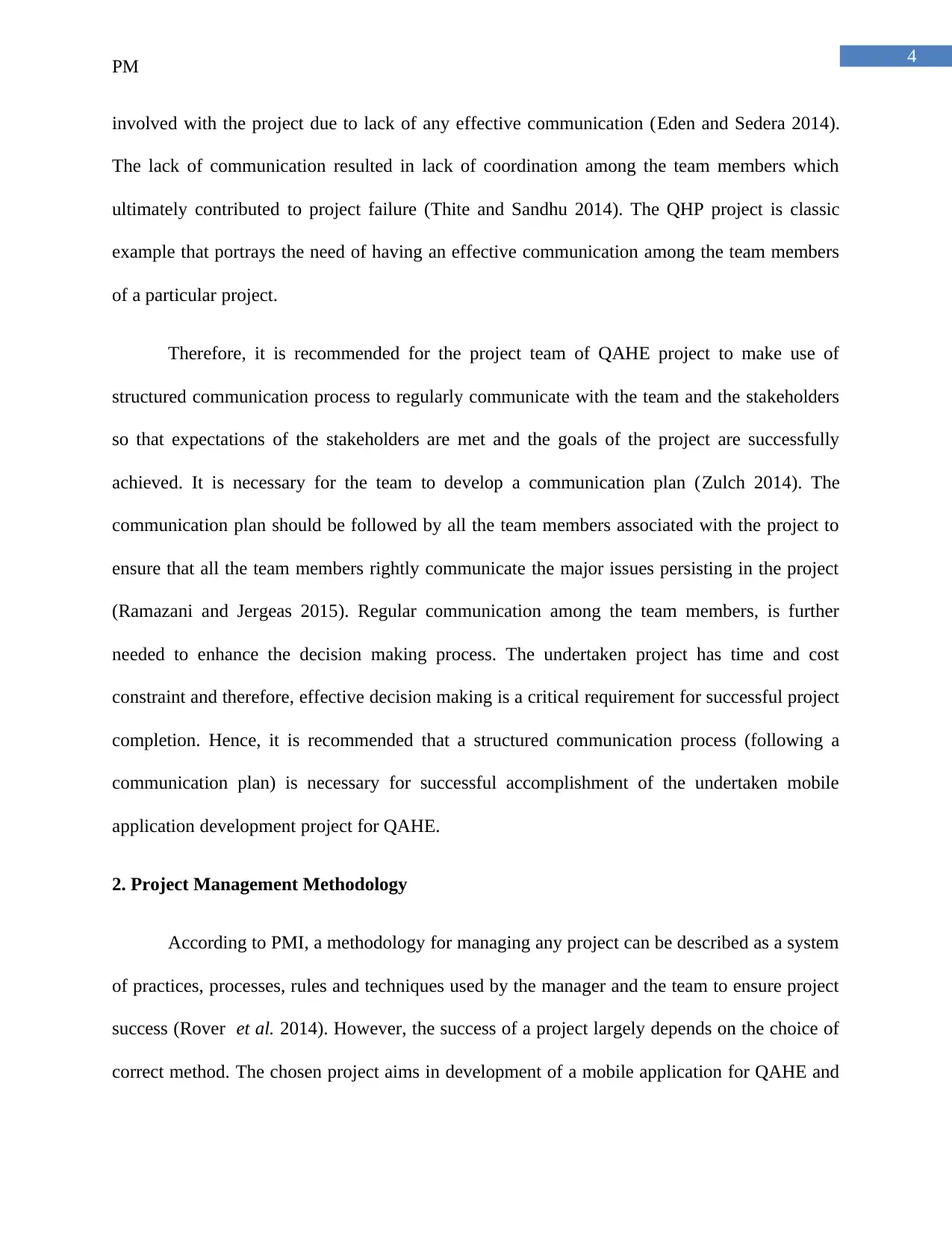
4
PM
involved with the project due to lack of any effective communication (Eden and Sedera 2014).
The lack of communication resulted in lack of coordination among the team members which
ultimately contributed to project failure (Thite and Sandhu 2014). The QHP project is classic
example that portrays the need of having an effective communication among the team members
of a particular project.
Therefore, it is recommended for the project team of QAHE project to make use of
structured communication process to regularly communicate with the team and the stakeholders
so that expectations of the stakeholders are met and the goals of the project are successfully
achieved. It is necessary for the team to develop a communication plan (Zulch 2014). The
communication plan should be followed by all the team members associated with the project to
ensure that all the team members rightly communicate the major issues persisting in the project
(Ramazani and Jergeas 2015). Regular communication among the team members, is further
needed to enhance the decision making process. The undertaken project has time and cost
constraint and therefore, effective decision making is a critical requirement for successful project
completion. Hence, it is recommended that a structured communication process (following a
communication plan) is necessary for successful accomplishment of the undertaken mobile
application development project for QAHE.
2. Project Management Methodology
According to PMI, a methodology for managing any project can be described as a system
of practices, processes, rules and techniques used by the manager and the team to ensure project
success (Rover et al. 2014). However, the success of a project largely depends on the choice of
correct method. The chosen project aims in development of a mobile application for QAHE and
PM
involved with the project due to lack of any effective communication (Eden and Sedera 2014).
The lack of communication resulted in lack of coordination among the team members which
ultimately contributed to project failure (Thite and Sandhu 2014). The QHP project is classic
example that portrays the need of having an effective communication among the team members
of a particular project.
Therefore, it is recommended for the project team of QAHE project to make use of
structured communication process to regularly communicate with the team and the stakeholders
so that expectations of the stakeholders are met and the goals of the project are successfully
achieved. It is necessary for the team to develop a communication plan (Zulch 2014). The
communication plan should be followed by all the team members associated with the project to
ensure that all the team members rightly communicate the major issues persisting in the project
(Ramazani and Jergeas 2015). Regular communication among the team members, is further
needed to enhance the decision making process. The undertaken project has time and cost
constraint and therefore, effective decision making is a critical requirement for successful project
completion. Hence, it is recommended that a structured communication process (following a
communication plan) is necessary for successful accomplishment of the undertaken mobile
application development project for QAHE.
2. Project Management Methodology
According to PMI, a methodology for managing any project can be described as a system
of practices, processes, rules and techniques used by the manager and the team to ensure project
success (Rover et al. 2014). However, the success of a project largely depends on the choice of
correct method. The chosen project aims in development of a mobile application for QAHE and
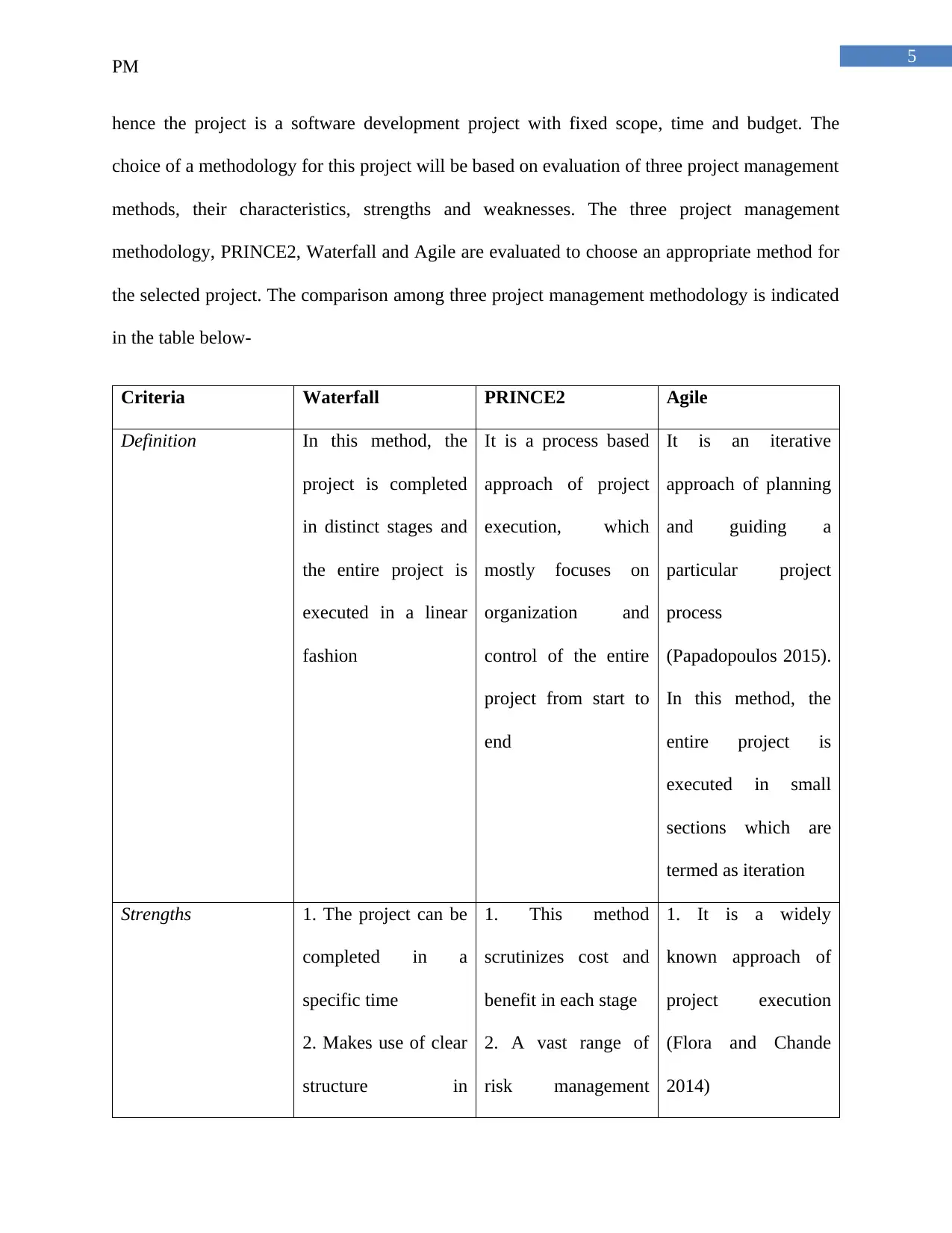
5
PM
hence the project is a software development project with fixed scope, time and budget. The
choice of a methodology for this project will be based on evaluation of three project management
methods, their characteristics, strengths and weaknesses. The three project management
methodology, PRINCE2, Waterfall and Agile are evaluated to choose an appropriate method for
the selected project. The comparison among three project management methodology is indicated
in the table below-
Criteria Waterfall PRINCE2 Agile
Definition In this method, the
project is completed
in distinct stages and
the entire project is
executed in a linear
fashion
It is a process based
approach of project
execution, which
mostly focuses on
organization and
control of the entire
project from start to
end
It is an iterative
approach of planning
and guiding a
particular project
process
(Papadopoulos 2015).
In this method, the
entire project is
executed in small
sections which are
termed as iteration
Strengths 1. The project can be
completed in a
specific time
2. Makes use of clear
structure in
1. This method
scrutinizes cost and
benefit in each stage
2. A vast range of
risk management
1. It is a widely
known approach of
project execution
(Flora and Chande
2014)
PM
hence the project is a software development project with fixed scope, time and budget. The
choice of a methodology for this project will be based on evaluation of three project management
methods, their characteristics, strengths and weaknesses. The three project management
methodology, PRINCE2, Waterfall and Agile are evaluated to choose an appropriate method for
the selected project. The comparison among three project management methodology is indicated
in the table below-
Criteria Waterfall PRINCE2 Agile
Definition In this method, the
project is completed
in distinct stages and
the entire project is
executed in a linear
fashion
It is a process based
approach of project
execution, which
mostly focuses on
organization and
control of the entire
project from start to
end
It is an iterative
approach of planning
and guiding a
particular project
process
(Papadopoulos 2015).
In this method, the
entire project is
executed in small
sections which are
termed as iteration
Strengths 1. The project can be
completed in a
specific time
2. Makes use of clear
structure in
1. This method
scrutinizes cost and
benefit in each stage
2. A vast range of
risk management
1. It is a widely
known approach of
project execution
(Flora and Chande
2014)
⊘ This is a preview!⊘
Do you want full access?
Subscribe today to unlock all pages.

Trusted by 1+ million students worldwide
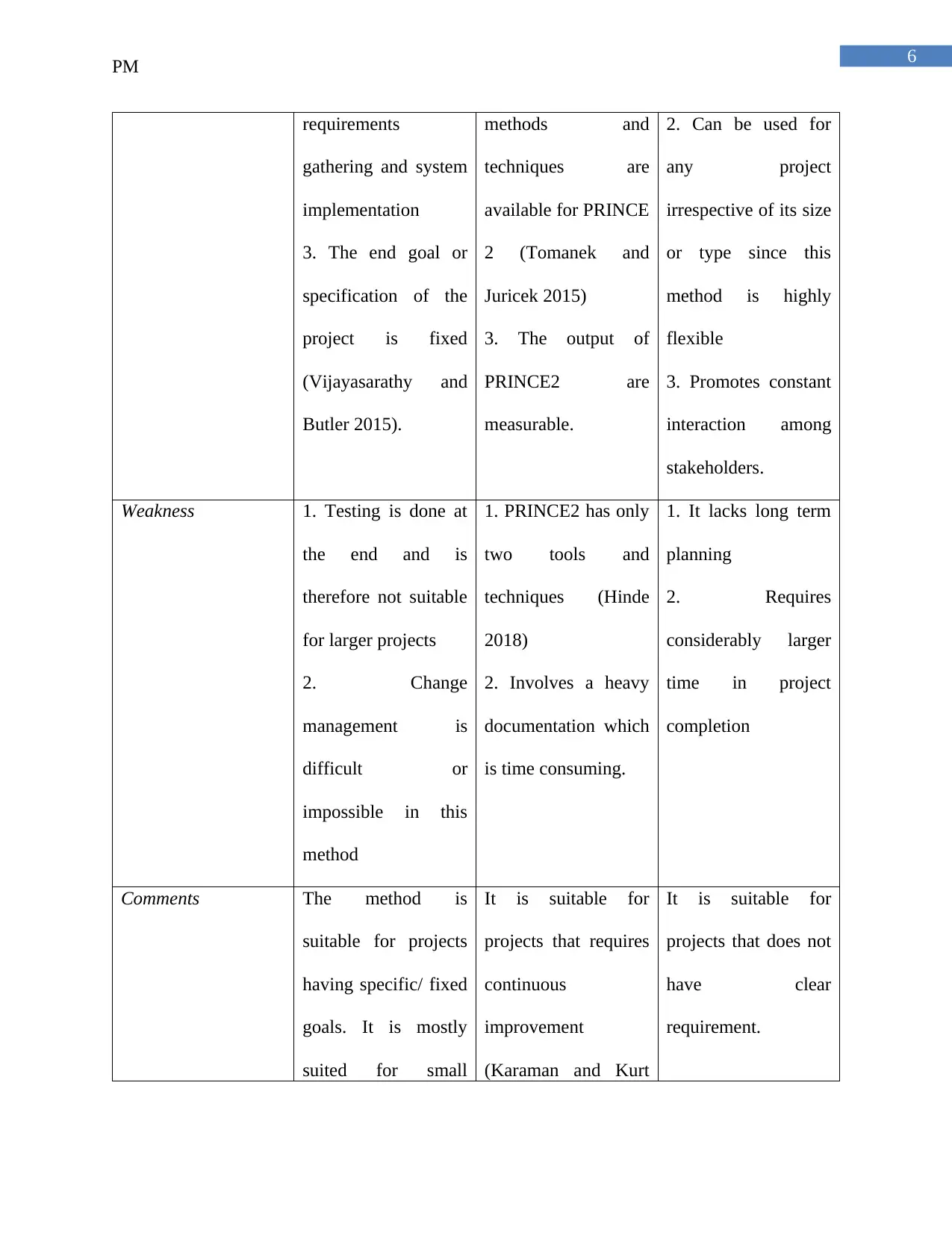
6
PM
requirements
gathering and system
implementation
3. The end goal or
specification of the
project is fixed
(Vijayasarathy and
Butler 2015).
methods and
techniques are
available for PRINCE
2 (Tomanek and
Juricek 2015)
3. The output of
PRINCE2 are
measurable.
2. Can be used for
any project
irrespective of its size
or type since this
method is highly
flexible
3. Promotes constant
interaction among
stakeholders.
Weakness 1. Testing is done at
the end and is
therefore not suitable
for larger projects
2. Change
management is
difficult or
impossible in this
method
1. PRINCE2 has only
two tools and
techniques (Hinde
2018)
2. Involves a heavy
documentation which
is time consuming.
1. It lacks long term
planning
2. Requires
considerably larger
time in project
completion
Comments The method is
suitable for projects
having specific/ fixed
goals. It is mostly
suited for small
It is suitable for
projects that requires
continuous
improvement
(Karaman and Kurt
It is suitable for
projects that does not
have clear
requirement.
PM
requirements
gathering and system
implementation
3. The end goal or
specification of the
project is fixed
(Vijayasarathy and
Butler 2015).
methods and
techniques are
available for PRINCE
2 (Tomanek and
Juricek 2015)
3. The output of
PRINCE2 are
measurable.
2. Can be used for
any project
irrespective of its size
or type since this
method is highly
flexible
3. Promotes constant
interaction among
stakeholders.
Weakness 1. Testing is done at
the end and is
therefore not suitable
for larger projects
2. Change
management is
difficult or
impossible in this
method
1. PRINCE2 has only
two tools and
techniques (Hinde
2018)
2. Involves a heavy
documentation which
is time consuming.
1. It lacks long term
planning
2. Requires
considerably larger
time in project
completion
Comments The method is
suitable for projects
having specific/ fixed
goals. It is mostly
suited for small
It is suitable for
projects that requires
continuous
improvement
(Karaman and Kurt
It is suitable for
projects that does not
have clear
requirement.
Paraphrase This Document
Need a fresh take? Get an instant paraphrase of this document with our AI Paraphraser
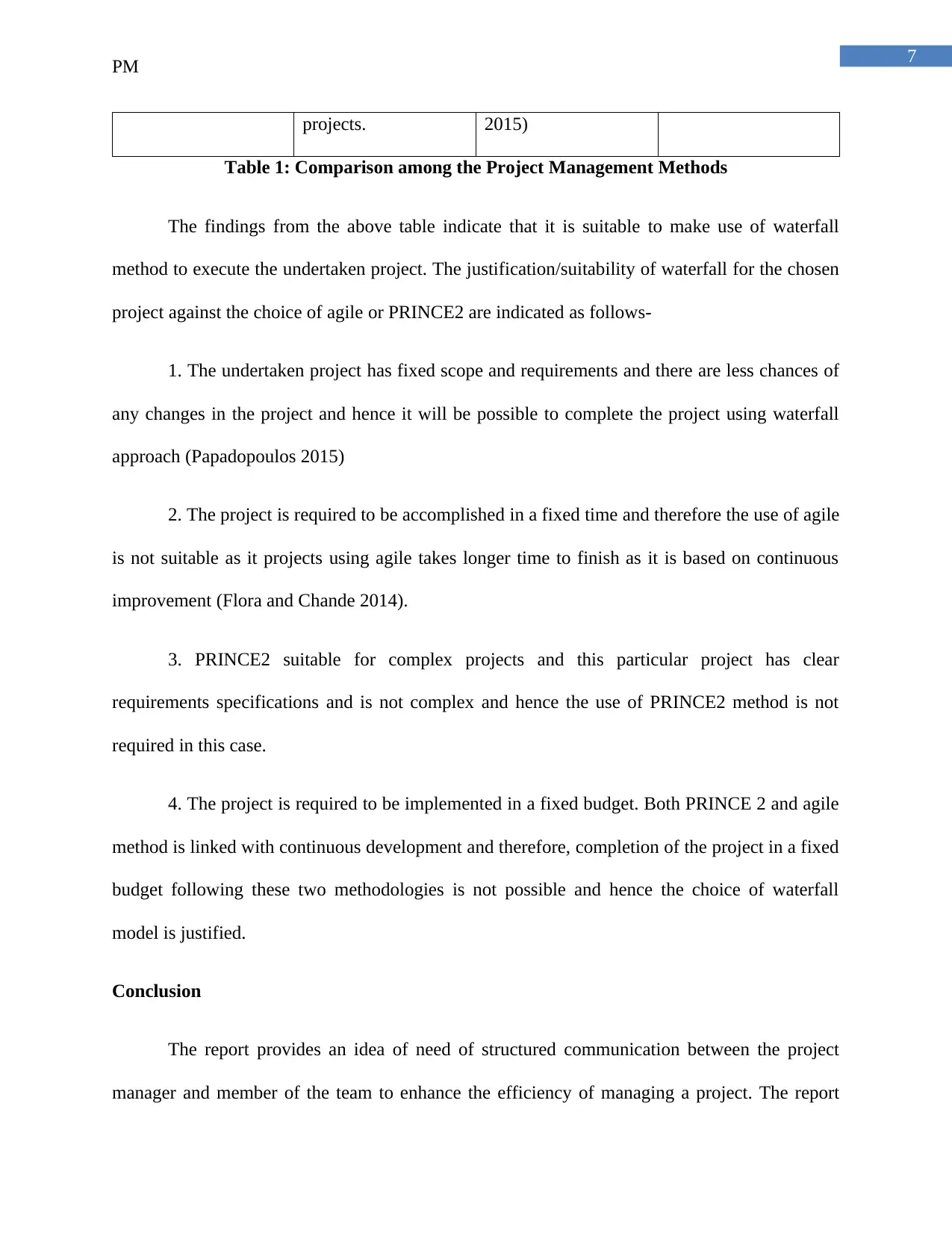
7
PM
projects. 2015)
Table 1: Comparison among the Project Management Methods
The findings from the above table indicate that it is suitable to make use of waterfall
method to execute the undertaken project. The justification/suitability of waterfall for the chosen
project against the choice of agile or PRINCE2 are indicated as follows-
1. The undertaken project has fixed scope and requirements and there are less chances of
any changes in the project and hence it will be possible to complete the project using waterfall
approach (Papadopoulos 2015)
2. The project is required to be accomplished in a fixed time and therefore the use of agile
is not suitable as it projects using agile takes longer time to finish as it is based on continuous
improvement (Flora and Chande 2014).
3. PRINCE2 suitable for complex projects and this particular project has clear
requirements specifications and is not complex and hence the use of PRINCE2 method is not
required in this case.
4. The project is required to be implemented in a fixed budget. Both PRINCE 2 and agile
method is linked with continuous development and therefore, completion of the project in a fixed
budget following these two methodologies is not possible and hence the choice of waterfall
model is justified.
Conclusion
The report provides an idea of need of structured communication between the project
manager and member of the team to enhance the efficiency of managing a project. The report
PM
projects. 2015)
Table 1: Comparison among the Project Management Methods
The findings from the above table indicate that it is suitable to make use of waterfall
method to execute the undertaken project. The justification/suitability of waterfall for the chosen
project against the choice of agile or PRINCE2 are indicated as follows-
1. The undertaken project has fixed scope and requirements and there are less chances of
any changes in the project and hence it will be possible to complete the project using waterfall
approach (Papadopoulos 2015)
2. The project is required to be accomplished in a fixed time and therefore the use of agile
is not suitable as it projects using agile takes longer time to finish as it is based on continuous
improvement (Flora and Chande 2014).
3. PRINCE2 suitable for complex projects and this particular project has clear
requirements specifications and is not complex and hence the use of PRINCE2 method is not
required in this case.
4. The project is required to be implemented in a fixed budget. Both PRINCE 2 and agile
method is linked with continuous development and therefore, completion of the project in a fixed
budget following these two methodologies is not possible and hence the choice of waterfall
model is justified.
Conclusion
The report provides an idea of need of structured communication between the project
manager and member of the team to enhance the efficiency of managing a project. The report
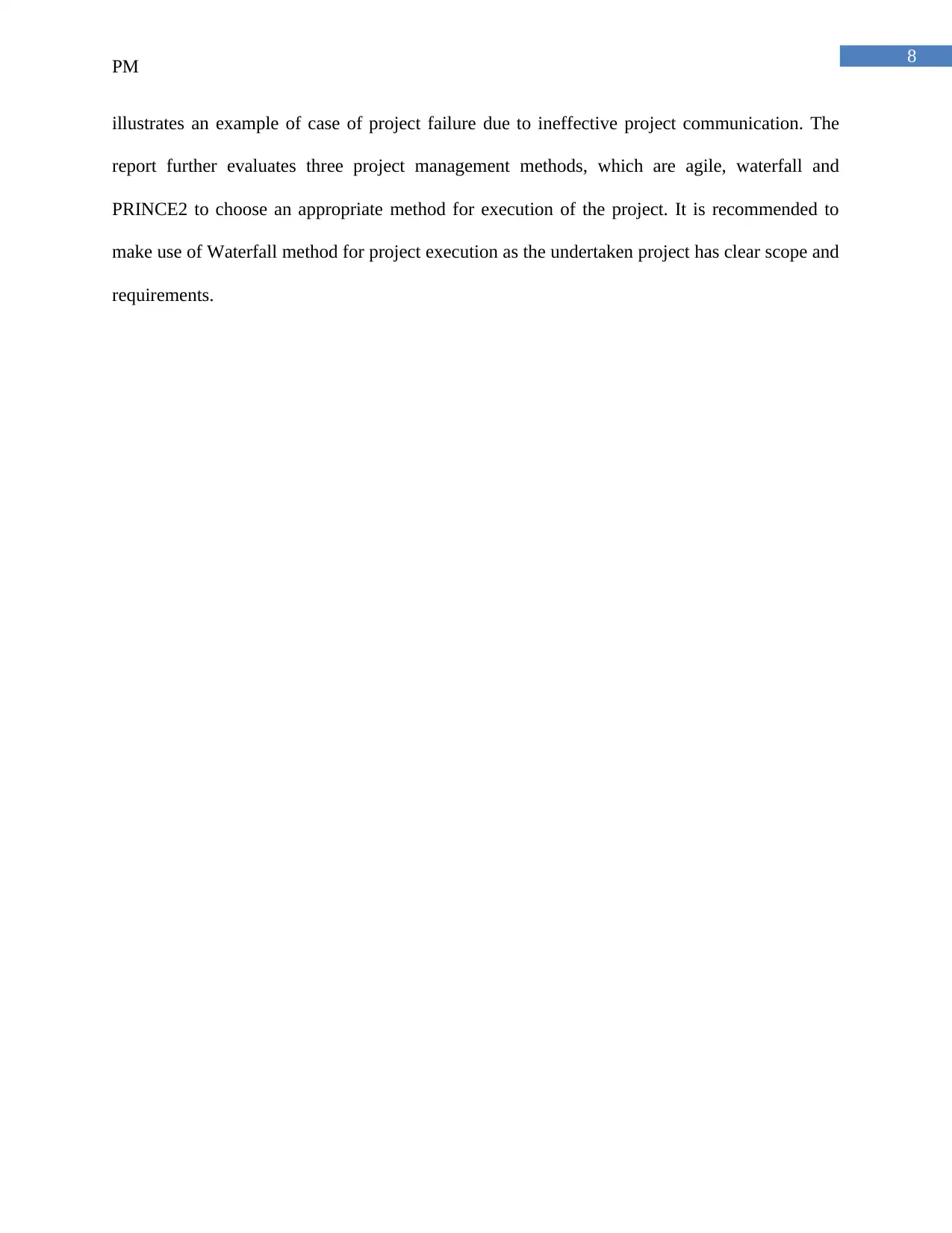
8
PM
illustrates an example of case of project failure due to ineffective project communication. The
report further evaluates three project management methods, which are agile, waterfall and
PRINCE2 to choose an appropriate method for execution of the project. It is recommended to
make use of Waterfall method for project execution as the undertaken project has clear scope and
requirements.
PM
illustrates an example of case of project failure due to ineffective project communication. The
report further evaluates three project management methods, which are agile, waterfall and
PRINCE2 to choose an appropriate method for execution of the project. It is recommended to
make use of Waterfall method for project execution as the undertaken project has clear scope and
requirements.
⊘ This is a preview!⊘
Do you want full access?
Subscribe today to unlock all pages.

Trusted by 1+ million students worldwide
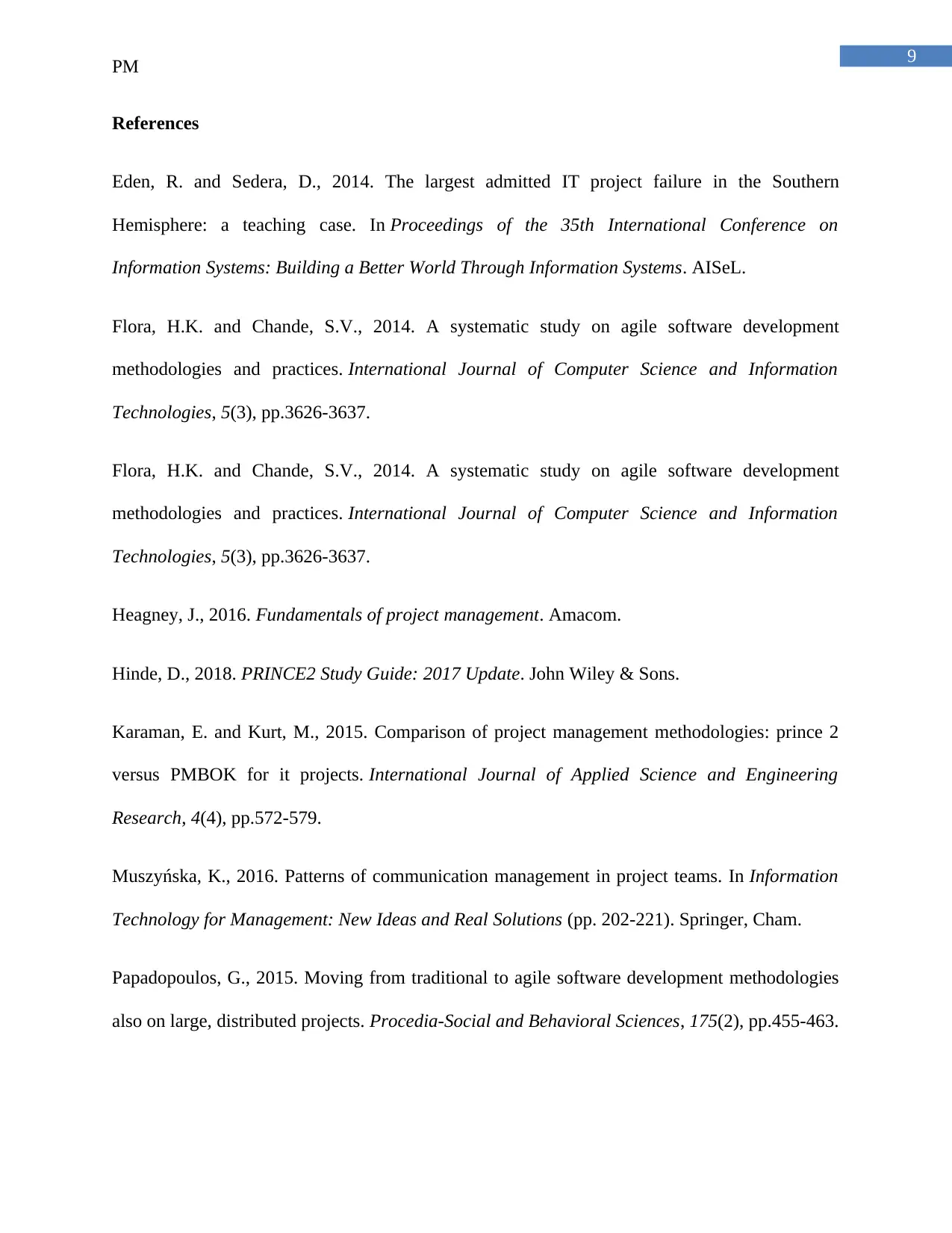
9
PM
References
Eden, R. and Sedera, D., 2014. The largest admitted IT project failure in the Southern
Hemisphere: a teaching case. In Proceedings of the 35th International Conference on
Information Systems: Building a Better World Through Information Systems. AISeL.
Flora, H.K. and Chande, S.V., 2014. A systematic study on agile software development
methodologies and practices. International Journal of Computer Science and Information
Technologies, 5(3), pp.3626-3637.
Flora, H.K. and Chande, S.V., 2014. A systematic study on agile software development
methodologies and practices. International Journal of Computer Science and Information
Technologies, 5(3), pp.3626-3637.
Heagney, J., 2016. Fundamentals of project management. Amacom.
Hinde, D., 2018. PRINCE2 Study Guide: 2017 Update. John Wiley & Sons.
Karaman, E. and Kurt, M., 2015. Comparison of project management methodologies: prince 2
versus PMBOK for it projects. International Journal of Applied Science and Engineering
Research, 4(4), pp.572-579.
Muszyńska, K., 2016. Patterns of communication management in project teams. In Information
Technology for Management: New Ideas and Real Solutions (pp. 202-221). Springer, Cham.
Papadopoulos, G., 2015. Moving from traditional to agile software development methodologies
also on large, distributed projects. Procedia-Social and Behavioral Sciences, 175(2), pp.455-463.
PM
References
Eden, R. and Sedera, D., 2014. The largest admitted IT project failure in the Southern
Hemisphere: a teaching case. In Proceedings of the 35th International Conference on
Information Systems: Building a Better World Through Information Systems. AISeL.
Flora, H.K. and Chande, S.V., 2014. A systematic study on agile software development
methodologies and practices. International Journal of Computer Science and Information
Technologies, 5(3), pp.3626-3637.
Flora, H.K. and Chande, S.V., 2014. A systematic study on agile software development
methodologies and practices. International Journal of Computer Science and Information
Technologies, 5(3), pp.3626-3637.
Heagney, J., 2016. Fundamentals of project management. Amacom.
Hinde, D., 2018. PRINCE2 Study Guide: 2017 Update. John Wiley & Sons.
Karaman, E. and Kurt, M., 2015. Comparison of project management methodologies: prince 2
versus PMBOK for it projects. International Journal of Applied Science and Engineering
Research, 4(4), pp.572-579.
Muszyńska, K., 2016. Patterns of communication management in project teams. In Information
Technology for Management: New Ideas and Real Solutions (pp. 202-221). Springer, Cham.
Papadopoulos, G., 2015. Moving from traditional to agile software development methodologies
also on large, distributed projects. Procedia-Social and Behavioral Sciences, 175(2), pp.455-463.
Paraphrase This Document
Need a fresh take? Get an instant paraphrase of this document with our AI Paraphraser
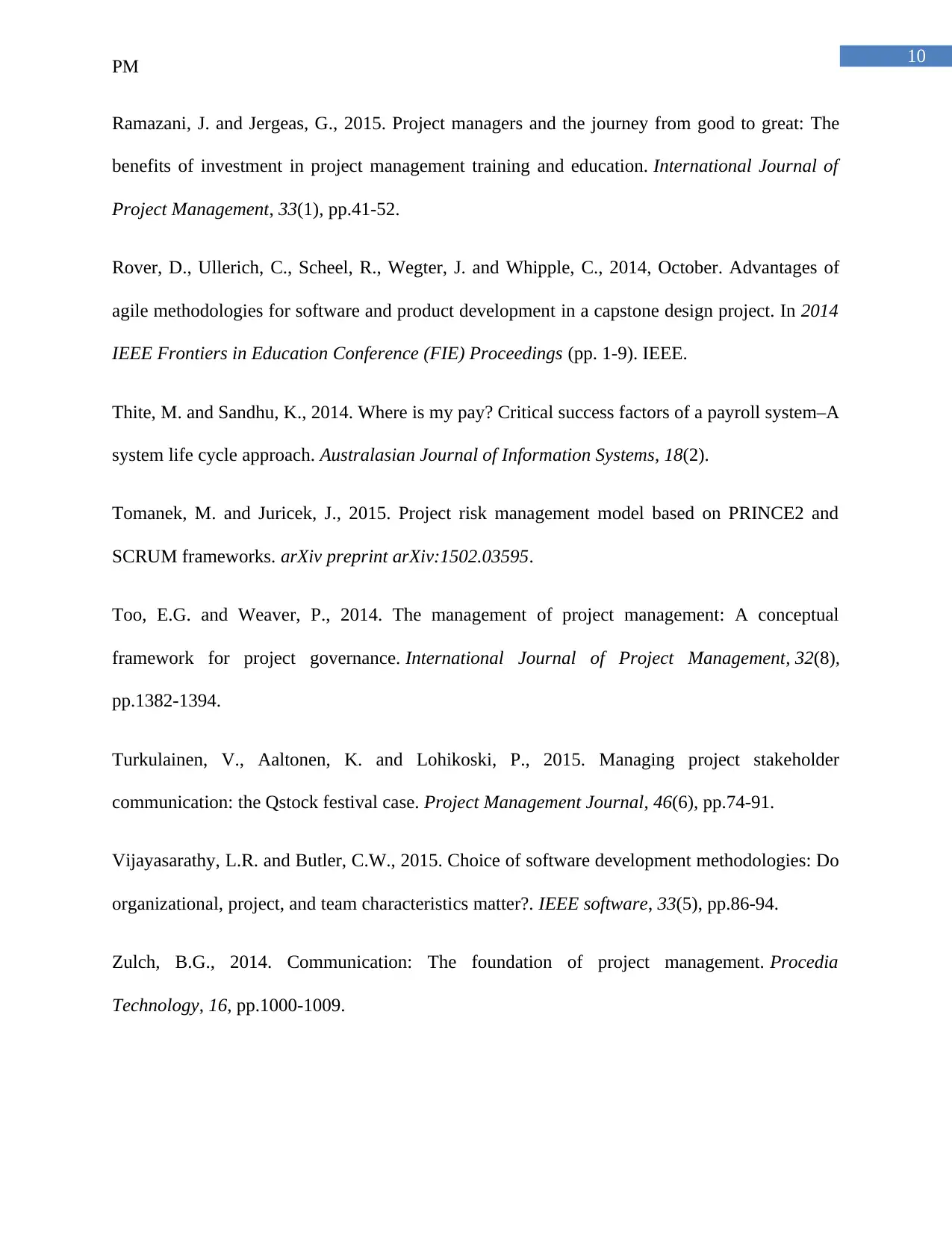
10
PM
Ramazani, J. and Jergeas, G., 2015. Project managers and the journey from good to great: The
benefits of investment in project management training and education. International Journal of
Project Management, 33(1), pp.41-52.
Rover, D., Ullerich, C., Scheel, R., Wegter, J. and Whipple, C., 2014, October. Advantages of
agile methodologies for software and product development in a capstone design project. In 2014
IEEE Frontiers in Education Conference (FIE) Proceedings (pp. 1-9). IEEE.
Thite, M. and Sandhu, K., 2014. Where is my pay? Critical success factors of a payroll system–A
system life cycle approach. Australasian Journal of Information Systems, 18(2).
Tomanek, M. and Juricek, J., 2015. Project risk management model based on PRINCE2 and
SCRUM frameworks. arXiv preprint arXiv:1502.03595.
Too, E.G. and Weaver, P., 2014. The management of project management: A conceptual
framework for project governance. International Journal of Project Management, 32(8),
pp.1382-1394.
Turkulainen, V., Aaltonen, K. and Lohikoski, P., 2015. Managing project stakeholder
communication: the Qstock festival case. Project Management Journal, 46(6), pp.74-91.
Vijayasarathy, L.R. and Butler, C.W., 2015. Choice of software development methodologies: Do
organizational, project, and team characteristics matter?. IEEE software, 33(5), pp.86-94.
Zulch, B.G., 2014. Communication: The foundation of project management. Procedia
Technology, 16, pp.1000-1009.
PM
Ramazani, J. and Jergeas, G., 2015. Project managers and the journey from good to great: The
benefits of investment in project management training and education. International Journal of
Project Management, 33(1), pp.41-52.
Rover, D., Ullerich, C., Scheel, R., Wegter, J. and Whipple, C., 2014, October. Advantages of
agile methodologies for software and product development in a capstone design project. In 2014
IEEE Frontiers in Education Conference (FIE) Proceedings (pp. 1-9). IEEE.
Thite, M. and Sandhu, K., 2014. Where is my pay? Critical success factors of a payroll system–A
system life cycle approach. Australasian Journal of Information Systems, 18(2).
Tomanek, M. and Juricek, J., 2015. Project risk management model based on PRINCE2 and
SCRUM frameworks. arXiv preprint arXiv:1502.03595.
Too, E.G. and Weaver, P., 2014. The management of project management: A conceptual
framework for project governance. International Journal of Project Management, 32(8),
pp.1382-1394.
Turkulainen, V., Aaltonen, K. and Lohikoski, P., 2015. Managing project stakeholder
communication: the Qstock festival case. Project Management Journal, 46(6), pp.74-91.
Vijayasarathy, L.R. and Butler, C.W., 2015. Choice of software development methodologies: Do
organizational, project, and team characteristics matter?. IEEE software, 33(5), pp.86-94.
Zulch, B.G., 2014. Communication: The foundation of project management. Procedia
Technology, 16, pp.1000-1009.

11
PM
PM
⊘ This is a preview!⊘
Do you want full access?
Subscribe today to unlock all pages.

Trusted by 1+ million students worldwide
1 out of 12
Related Documents
Your All-in-One AI-Powered Toolkit for Academic Success.
+13062052269
info@desklib.com
Available 24*7 on WhatsApp / Email
![[object Object]](/_next/static/media/star-bottom.7253800d.svg)
Unlock your academic potential
Copyright © 2020–2025 A2Z Services. All Rights Reserved. Developed and managed by ZUCOL.





